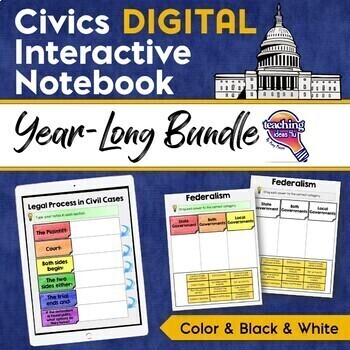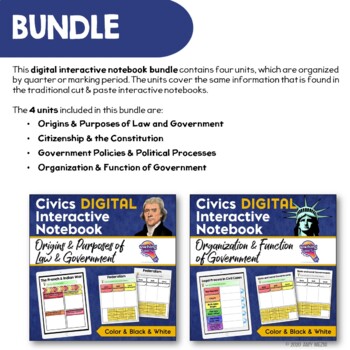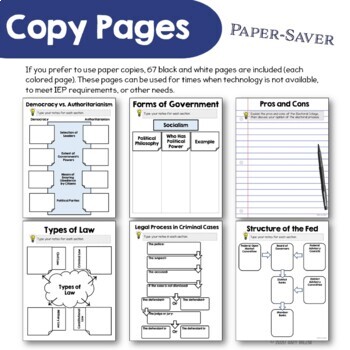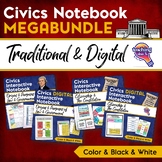Civics & U.S. Government DIGITAL Interactive Notebook BUNDLE / Digital Learning
- Zip
- Google Apps™
- Microsoft OneDrive

What educators are saying
Products in this Bundle (4)
Also included in
- Civics & U.S. Government Traditional & Digital Interactive Notebook MegaBundleAre you looking for Civics & U.S. Government interactive notebooks, but want the flexibility to take notes both on interactive pieces and digitally? This bundle contains both my paper bundle and digital bundlePrice $59.97Original Price $87.50Save $27.53
Description
Civics & U.S. Government DIGITAL Interactive Notebook GROWING BUNDLE
This resource is a Civics and U.S. Government DIGITAL Interactive Notebook BUNDLE for middle or high school. The digital interactive notebooks can be used during your class lessons or it can be used as part of an intensive review/study guide for the End of Course (EOC) exam.
The four quarterly units included in this bundle are:
- Origins & Purposes of Law & Government
- Citizenship & the U.S. Constitution
- Government Policies & Political Processes
- Organization & Function of Government
Are the units editable?
The topics and questions are not editable. The answers in the answer key are editable, so teachers can edited them to fit the resource or textbook they have.
The organizers have text boxes placed on top of them, so they are ready for student use.
Please note that content is not included. In this file are graphic organizers to help your student organize his or her civics notebook. On the graphic organizers are topics and/or questions to guide him/her.
**Please be advised that this should be completed with an instructor or a parent, as students may need guidance in adding their notes.**
How to Get the Files
Teachers will obtain the file by using links in a pdf file. Clicking those links will take teachers to an webpage that will have them make a copy of the original files in their Google Drive. Please make sure you are logged into the Google account when you click the links, as it will copy the files to whatever Google account you are logged into at the time.
The files can be downloaded and moved to Microsoft One Note or another online platform.
Teachers have permission to post the images online for their students on a password protected site.
Standards Covered
This file has been designed to help students study for the Florida 7th grade Civics End of Course (EOC) exam. The topics in this file cover the following standards:
SS.7.C.1.1 Recognize how Enlightenment ideas including Montesquieu's view of separation of power and John Locke's theories related to natural law and how Locke's social contract influenced the Founding Fathers.
SS.7.C.1.2 Trace the impact that the Magna Carta, English Bill of Rights, Mayflower Compact, and Thomas Paine's "Common Sense" had on colonists' views of government.
SS.7.C.1.3 Describe how English policies and responses to colonial concerns led to the writing of the Declaration of Independence.
SS.7.C.1.4 Analyze the ideas (natural rights, role of the government) and complaints set forth in the Declaration of Independence.
SS.7.C.1.5 Identify how the weaknesses of the Articles of Confederation led to the writing of the Constitution.
SS.7.C.1.6 Interpret the intentions of the Preamble of the Constitution.
SS.7.C.1.7 Describe how the Constitution limits the powers of government through separation of powers and checks and balances.
SS.7.C.1.8 Explain the viewpoints of the Federalists and the Anti-Federalists regarding the ratification of the Constitution and inclusion of a bill of rights.
SS.7.C.1.9 Define the rule of law and recognize its influence on the development of the American legal, political, and governmental systems.
SS.7.C.3.5 Explain the Constitutional amendment process.
SS.7.C.2.1 Define the term "citizen," and identify legal means of becoming a United States citizen.
SS.7.C.2.2 Evaluate the obligations citizens have to obey laws, pay taxes, defend the nation, and serve on juries.
SS.7.C.2.4 Evaluate rights contained in the Bill of Rights and other amendments to the Constitution.
SS.7.C.2.5 Distinguish how the Constitution safeguards and limits individual rights.
SS.7.C.3.12 Analyze the significance and outcomes of landmark Supreme Court cases.
SS.7.C.3.14 Differentiate between local, state, and federal governments' obligations and services.
SS.7.C.3.3 Illustrate the structure and function (three branches of government established in Articles I, II, and III with corresponding powers) of government in the United States as established in the Constitution.
SS.7.C.3.6 Evaluate Constitutional rights & their impact on individuals and society.
SS.7.C.3.7 Analyze the impact of the 13th, 14th, 15th, 19th, 24th, and 26th amendments on participation of minority groups in the American political process.
SS.7.C.3.8 Analyze the structure, functions, and processes of the legislative, executive, and judicial branches.
SS.7.C.3.9 Illustrate the law making process at the local, state, and federal levels.
SS.7.C.2.10 Examine the impact of media, individuals, and interest groups on monitoring and influencing government.
SS.7.C.2.11 Analyze media and political communications (bias, symbolism, propaganda).
SS.7.C.2.8 Identify America's current political parties, and illustrate their ideas about government.
SS.7.C.4.1 Differentiate concepts related to United States domestic and foreign policy.
SS.7.C.4.2 Recognize government and citizen participation in international organizations.
SS.7.C.4.3 Describe examples of how the United States has dealt with international conflicts.
SS.7.E.1.2 Discuss the government's role in controlling financial institutions,
SS.7.E.1.3 Review the concepts of supply and demand, choice, scarcity, and opportunity cost as they relate to the development of the mixed market economy in the United States.
SS.7.E.2.1 Explain how federal, state, and local taxes support the economy as a function of the United States government.
SS.7.E.2.2 Describe the banking system in the United States and its impact on the money supply.
SS.7.C.3.1 Compare different forms of government (direct democracy, representative democracy, socialism, communism, monarchy, oligarchy, autocracy).
SS.7.C.3.10 Identify sources and types (civil, criminal, constitutional, military) of law.
SS.7.C.3.11 Diagram the levels, functions, and powers of courts at the state and federal levels.
SS.7.C.3.13 Compare the constitutions of the United States and Florida.
SS.7.C.3.14 Differentiate between local, state, and federal governments' obligations and services.
SS.7.C. 3.2 Compare parliamentary, federal, confederal, and unitary systems of government.
SS.7.C.3.4 Identify the relationship and division of powers between the federal government and state governments.
SS.7.C.3.8 Analyze the structure, functions, and processes of the legislative, executive, and judicial branches.
SS.7.C.3.9 Illustrate the law making process at the local, state, and federal levels.
Although this file is written to the Florida standards, it can be used by anyone studying civics.
Other Civics Units Available
The cut and paste Civics & Government units are available separately:
Civics & Government Interactive Notebook: Origins & Purposes of Law & Government.
Civics & Government Interactive Notebook: Citizenship & the U.S. Constitution
Civics & Government Interactive Notebook: Government Policies & Political Processes
Civics & Government Interactive Notebook: Organization & Function of Government
Do you need flexibility?
Do you need both traditional paper graphic organizer and digital formats? Check out the Civics & U.S. Government Mega-Bundle Digital & Paper Interactive Notebook!
Having both bundles provides teachers with more flexibility in their teaching. For example:
- The black and white slides make it easy to accommodate students who need a full-page notesheet instead of cutting foldables.
- Running short on copies? Use the digital slides.
- Planning for a sub or computers are down? Use printables instead of digital files.
Purchasing the Mega-Bundle saves teachers 30% off the individual unit prices.
******************************
Customer Tips:
How to get TPT credit to use on future purchases:
• Please go to your My Purchases page (you may need to login). Beside each purchase you'll see a Provide Feedback button. Simply click it and you will be taken to a page where you can give a quick rating and leave a short comment for the product. Each time you give feedback, TPT gives you feedback credits that you use to lower the cost of your future purchases. I value your feedback greatly as it helps me determine which products are most valuable for your classroom so I can create more for you. ☺
Be the first to know about my new discounts, freebies and product launches:
• Look for the green star next to my store logo and click it to become a follower. Voila! You will now receive email updates about this store. ☺
******************************






